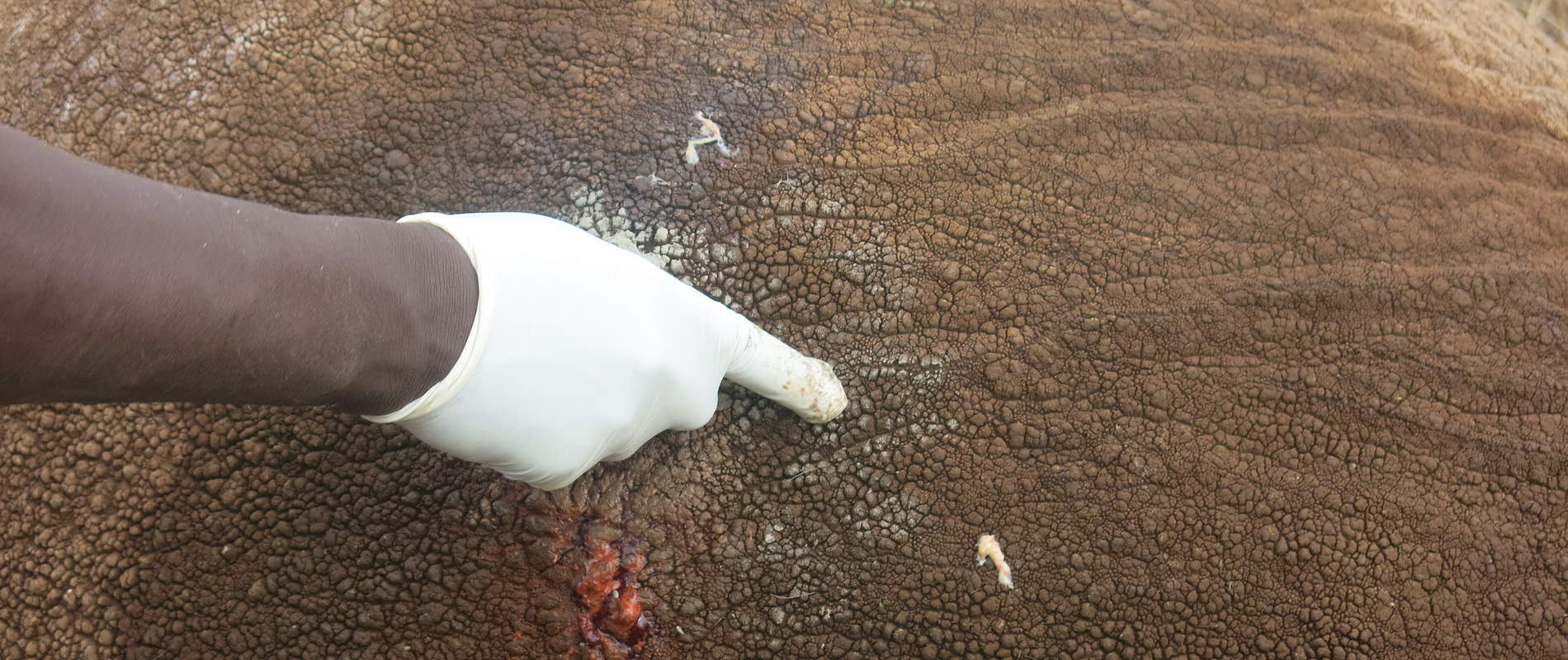FIELD VETERINARY REPORT FOR AMBOSELI MOBILE VET UNIT FOR THE MONTH OF MARCH 2014 Report by Dr
FIELD VETERINARY REPORT FOR AMBOSELI MOBILE VET UNIT FOR THE MONTH OF MARCH 2014
Report by Dr. Michael Njoroge
Introduction
This month the Southern Conservation Area showed a marked increase in the number of cases being reported to the Mobile Veterinary Unit. This has been attributed to the dry weather in the region, which has resulted in more interaction between wildlife, livestock and humans and an escalation in conflicts. During the month, a combined team of the Kenya Wildlife Service Veterinary and Capture team and the Mobile Veterinary Unit undertook the translocation of 8 bull elephants from Engaronij area in Kajiado County to the Aberdare National Park and Amboseli National Park. These translocations were carried out in order to mitigate and reduce incidents of human-wildlife conflict.






CASE#1 RESCUE OF ZEBRA FOAL
Date: 05th March 2015
Species: Plains Zebra (Equus quagga burchelli)
Sex: Female
Age: 2 months
Location: Oloile (Amboseli)
History
A female zebra foal was reported abandoned in Oloile, Amboseli ecosystem by rangers. Efforts were made to reunite with its mother but after 2 days these efforts proved futile and the decision was taken to rescue the foal.


Immobilisation and capture
Due to the age of the foal, the decision was made to restrain the foal physically rather than immobilizing her by darting. Once captured the foal was relocated to the DSWT stockade at Voi for further nurturing and care.


CASE#2 RESCUE OF ZEBRA
Date: 18th March 2015
Species: Plains Zebra (Equus quagga burchelli)
Sex: Female
Age: Foal
Location: Namelok (Amboseli)
History
A young female zebra was reported to be stuck in a dried well in Namelok area. The young zebra had been stuck for about 6 hours down the deep hole. The Mobile Vet Unit was alerted and attended the scene.


Immobilisation and rescue
After assessing the situation, the Mobile Vet Unit decided not to dart the zebra for retrieval due to the depth of the hole. Instead ropes were lowered down into the empty hole and placed securely around the foal’s flank and she was raised out of the water hole.
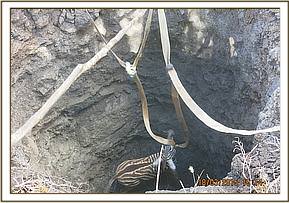

After being assessed by the Vet Unit for any injuries she was released back into the bush.
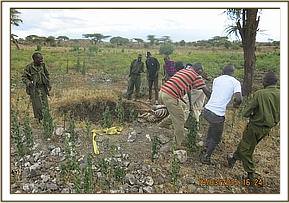

CASE#3 TREATMENT OF INJURED ELEPHANT
Date: 19th March 2015
Species: Elephant (Loxdonta africana africana)
Sex: Male
Age: 20 – 30 yrs
Location: Chyulu Hills
History
Big life rangers patrolling in the Chyulu Hills spotted a bull elephant with a suspected arrow injury to the top of his trunk. The rangers reported the case to the Mobile Veterinary Team who attended the case. Due to the thickness of the vegetation in the area where the bull had first been spotted, the Vet Team had to use a helicopter to locate and assess the elephant. Once located, plans were made to immobilize, examine and treat the elephant. Despite the thick bush, the elephant was relatively easy to dart from the helicopter after being pushed to slightly more open ground.
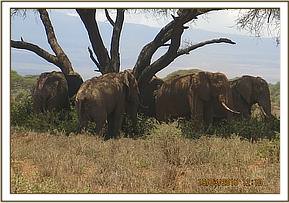

Immobilization, examination and treatment
The bull elephant was immobilized using 18mg Etorphine Hydrochloride in a 3ml Dan Inject dart administered from a helicopter. The elephant went down on his side after about 15 minutes. The trunk was kept open using a piece of stick placed across the nostrils and the ears were used as blindfolds. Due to the high ambient temperature, the bull was doused with water to keep him cool.


Upon closer examination, the elephant was found to have an approximately 1-2 week old 14 inch deep wound to his trunk, which was believed to have been caused by a bullet and not an arrow as originally reported.
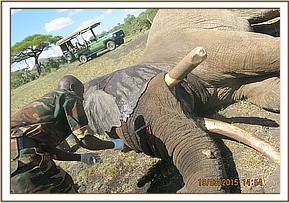

The wound was septic and contained necrotic tissue. The dead tissue was debrided and removed and the wound was thoroughly cleaned using water and Hydrogen Peroxide.
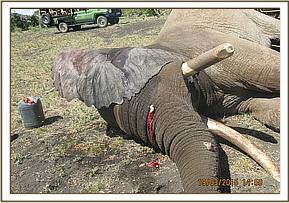

The wound was then lavaged using Tincture of Iodine. Topical antibiotic cream and green clay were applied into the wound to facilitate healing and to avoid infection. The elephant was injected with 100ml Amoxicillan, 1200mg Clindamycin and 100ml Dexamethasone at different sites intramuscularly. The entire operation lasted about 30 minutes.


Reversal
Reversal was achieved by administering 60mgs Diprenorphine Hydrochloride into the ear vein. It took about 6 minutes for the elephant to come round fully from the anaesthetic.


Prognosis
Prognosis is good.
CASE#4 TREATMENT OF INJURED ELEPHANT
Date: 21st March 2015
Species: Elephant (Loxdonta africana africana)
Sex: Male
Age: 30 – 35 yrs
Location: Komboyo (Tsavo West National Park)
History
While on a routine patrol, the DSWT pilot spotted an injured elephant. They reported the incident to the Mobile Veterinary Unit who immediately made plans to attend to the case. The elephant was located in thick bush and the terrain was rocky, so darting from a helicopter was considered the best option. The DSWT provided a helicopter for the exercise.


Immobilization, examination and treatment
The elephant was immobilized using 18mgs Etorphine Hydrochloride in a 3ml dart. Darting was done using the Dan Inject system from a helicopter. Full immobilization took place after 15 minutes and the elephant fell on his side. His trunk was kept open using a stick placed across the nostril entrances and his ears were used as blindfolds. Due to the high temperatures in Tsavo, water was doused onto his head and ears to keep him cool.
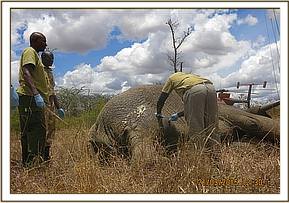

Upon physical examination, the elephant was found to have a penetrating wound to his right flank. The wound was septic and contained pus. The wound was thought to have been caused by an arrow. The dead tissue was debrided, the wound was drained of about 3 litres of pus and an arrow head was removed from the wound.
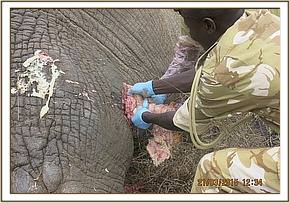

The wound was then thoroughly cleaned using water and Hydrogen Peroxide and lavaged using Tincture of Iodine. Topical antibiotic cream and green clay were packed into the wound to facilitate healing and avoid infection.
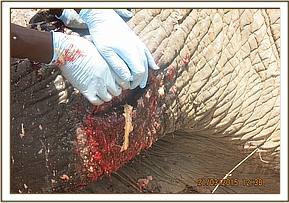

Finally the elephant was injected with 200ml Oxytetracycline and 100ml Flunixine Meglumine at different sites intramuscularly. The operation lasted about 40 minutes.
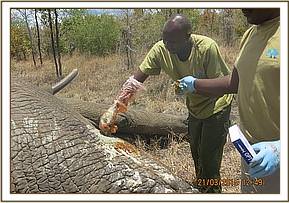

Reversal
Reversal was achieved by administration of 54mgs Diprenorphine Hydrochloride into the ear vein. It took about 6 minutes for the elephant to awaken fully from the anaesthetic and walk away from the site.


Prognosis
Prognosis is good
CASE#5 TREATMENT OF INJURED ZEBRA
Date: 22nd March 2015
Species: Plains Zebra (Equus quagga burchelli)
Sex: Male
Age: 3 – 5 months
Location: Amboseli National Park
History
A young zebra with an obvious injury was spotted by the Mobile Veterinary Team while on routine patrol. The Vet Team immediately made the decision to immobilize and examine the zebra.
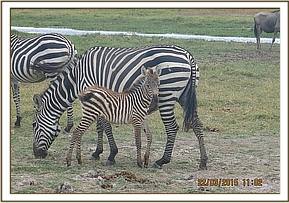

Immobilization, examination and treatment
The zebra was immobilized using 3 mgs Etorphine Hydrochloride and 20 mgs Azerperone in a 2ml dart. Darting was done from a vehicle using the Dan Inject system. Full immobilization took place after 5 minutes and he fell on his side. The zebra was blindfolded and opticlox was applied to the eyes to avoid damage.
Upon physical examination, the zebra was found to have a swelling and a septic injury to the left humeral joint, which could have been caused by an attack from a predator.


The wounds were thoroughly cleaned during clean water and Hydrogen Peroxide, and rinsed using saline solution. Dead tissue was debrided and the wounds were lavaged using Tincture of Iodine. Topical antibiotic cream and green clay were applied onto the wounds to facilitate healing and to avoid infection. Finally, the zebra was injected with 20ml Amoxicillan and 20ml Dexamethasone at different sites intramuscularly. The entire operation lasted 20 minutes.


Reversal
Reversal was achieved by administering 12mg Diprenorphine Hydrogenchloride intravenously and took about 4 minutes.
Prognosis
Prognosis is good.
CASE#6 TREATMENT OF INJURED ZEBRA
Date: 23rd March 2015
Species: Plains Zebra (Equus quagga burchelli)
Sex: Male
Age: Adult
Location: Sidai Oleng (Amboseli Ecosystem)
History
An injured male zebra was spotted by the KWS Intelligence team while on routine patrol. The Mobile Veterinary Team attended to the case and decided to immobilize, examine and treat the zebra.


Immobilization, examination and treatment
The zebra was immobilized using 7 mgs Etorphine Hydrochloride and 60 mgs Azerperone in a 3ml dart. Darting was done from a vehicle using the Dan Inject system. Full immobilization took place after 6 minutes and he fell on his side. The zebra was blindfolded and opticlox was applied to the eyes to avoid damage.
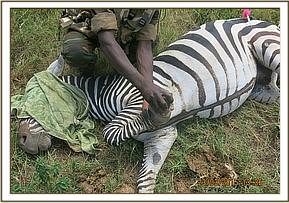

The zebra was observed to be lame as a result of an old, but healing injury. The limb was swollen at the hock joint, but no external injuries were visible. The zebra was injected with 50ml Amoxicillin and 50ml Flunixine Meglumin at different sites intramuscularly. The entire operation lasted 15 minutes.
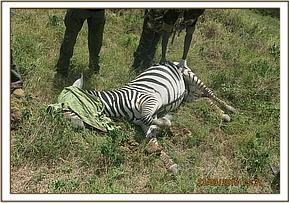

Reversal
Immobilisation was reversed by administering 21mgs Diprenorphine Hydrogenchloride and took about 4 minutes.
Prognosis
Prognosis is good
CASE#7 TREATMENT OF INJURED ZEBRA
Date: 24th March 2015
Species: Plains Zebra (Equus quagga burchelli)
Sex: Male
Age: 3 – 4 months
Location: Amboseli National Park
History
A young zebra was spotted within the park by Amboseli Trust for Elephants with a swollen right fore limb. The Mobile Veterinary Unit attend the case and darted the male zebra for examination and treatment.
Immobilization, examination and treatment
The zebra was immobilized using 3mgs Etorphine Hydrochloride and 20mgs Azerperone in a 2ml dart. Darting was done from a vehicle using a Dan Inject system. Full immobilization took place within 4 minutes and he fell on his side.


Upon physical examination the zebra was found to have an infected wound to his right forelimb. The young zebra had suffered a compound open fracture, probably as a result of a fall. A decision was made to euthanise the zebra using 10 ml Euthenize.


CASE#8 TREATMENT OF INJURED ELEPHANT
Date: 24th March 2015
Species: Elephant (Loxdonta africana africana)
Sex: Male
Age: 35 – 40 yrs
Location: Satao (Tsavo East)
History
The Big Life Rangers based in the Satao region spotted an injured elephant in the area while on their routine daily patrols. They made a report to the Mobile Veterinary Unit in Amboseli and the Vet Team immediately made plans to attend to the case. On arrival, the elephant was found in thick bushy terrain and therefore darting from foot was the only option.
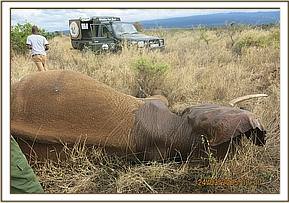

Immobilization, examination and treatment
The elephant was immobilized using 18mgs Etorphine Hydrochloride in a 3ml dart. Darting was done using the Dan Inject system from foot. Full immobilization took place after 12 minutes and the elephant fell on his side. His trunk was kept open using a stick placed across the nostril entrances and his ears were used as blindfolds.
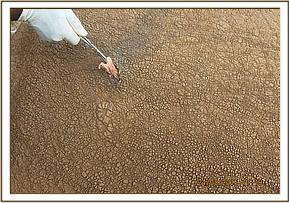

Upon physical examination, the elephant was found to have a penetrating wound to his left flank. The wound was septic and contained pus. The wound was thought to have been caused by a spear that had since fallen out. The dead tissue was debrided and thoroughly cleaned using water and Hydrogen Peroxide and lavaged using Tincture of Iodine.
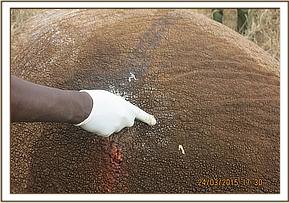

Topical antibiotic cream and green clay were packed into the wound to facilitate healing and avoid infection. Finally the elephant was injected with 100ml Oxytetracycline and 100ml Flunixine Meglumine at different sites intramuscularly. The operation lasted about 30 minutes.
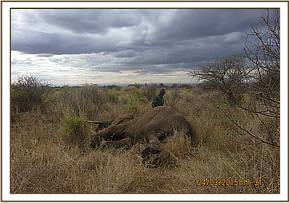

Reversal
Reversal was achieved by administration of 54mgs Diprenorphine Hydrochloride into the ear vein. It took about 8 minutes for the elephant to awaken fully from the anaesthetic and walk away from the site
Prognosis
Prognosis is good
CONCLUSION
The Southern Conservation Area Mobile Veterinary Unit is grateful to all individuals and organizations that played a role in assisting us to achieve our goal. Many thanks especially to The David Sheldrick Wildlife Trust, The Samuel J and Ethel Lefrak Charitable Trust and the Kenya Wildlife Service for their continued support, which allows this unit to alleviate animal suffering by immediately responding to clinical interventions and wildlife rescues.
